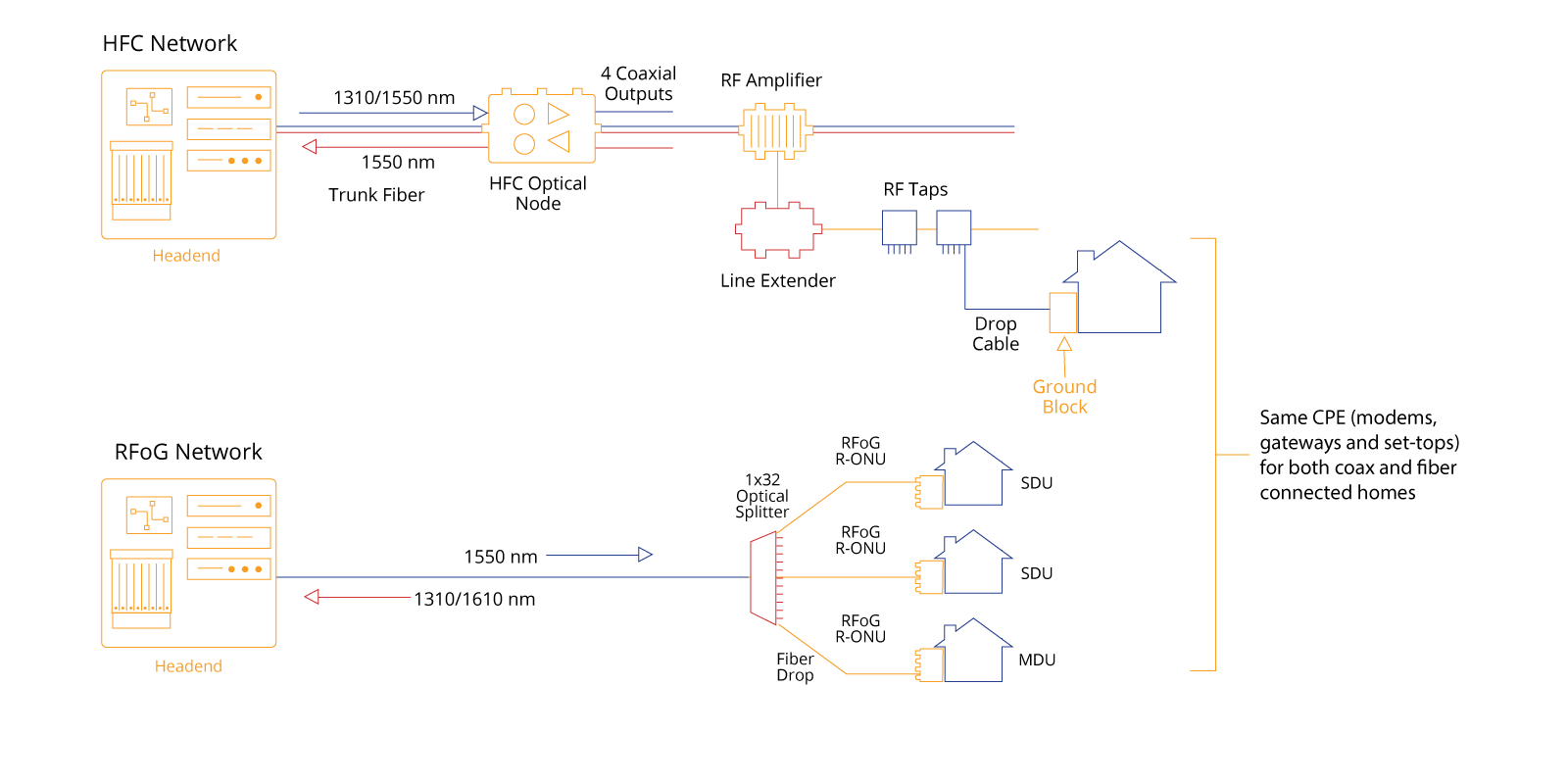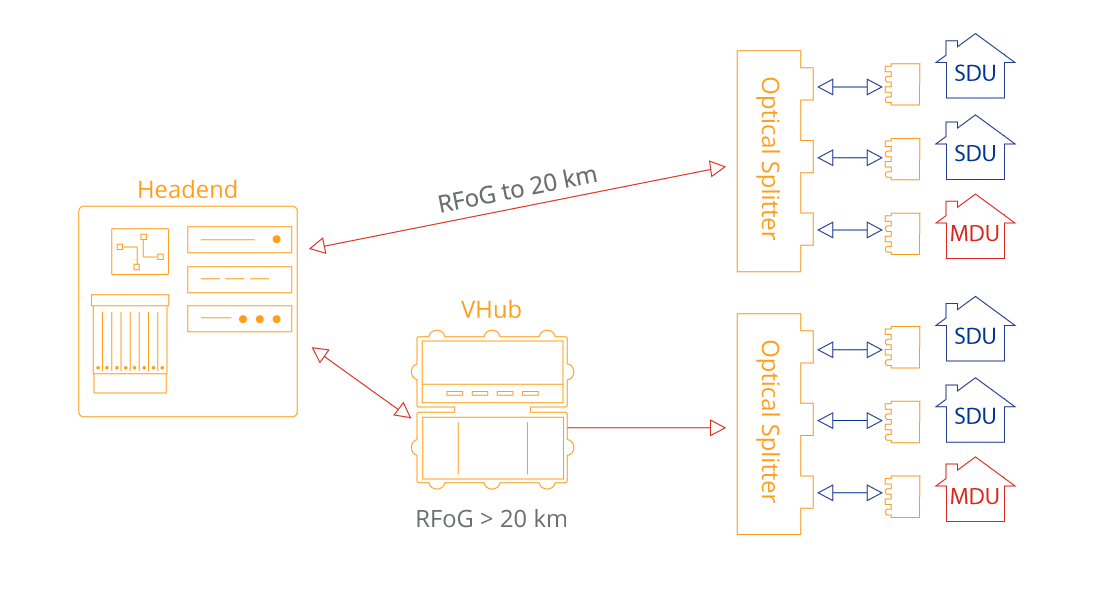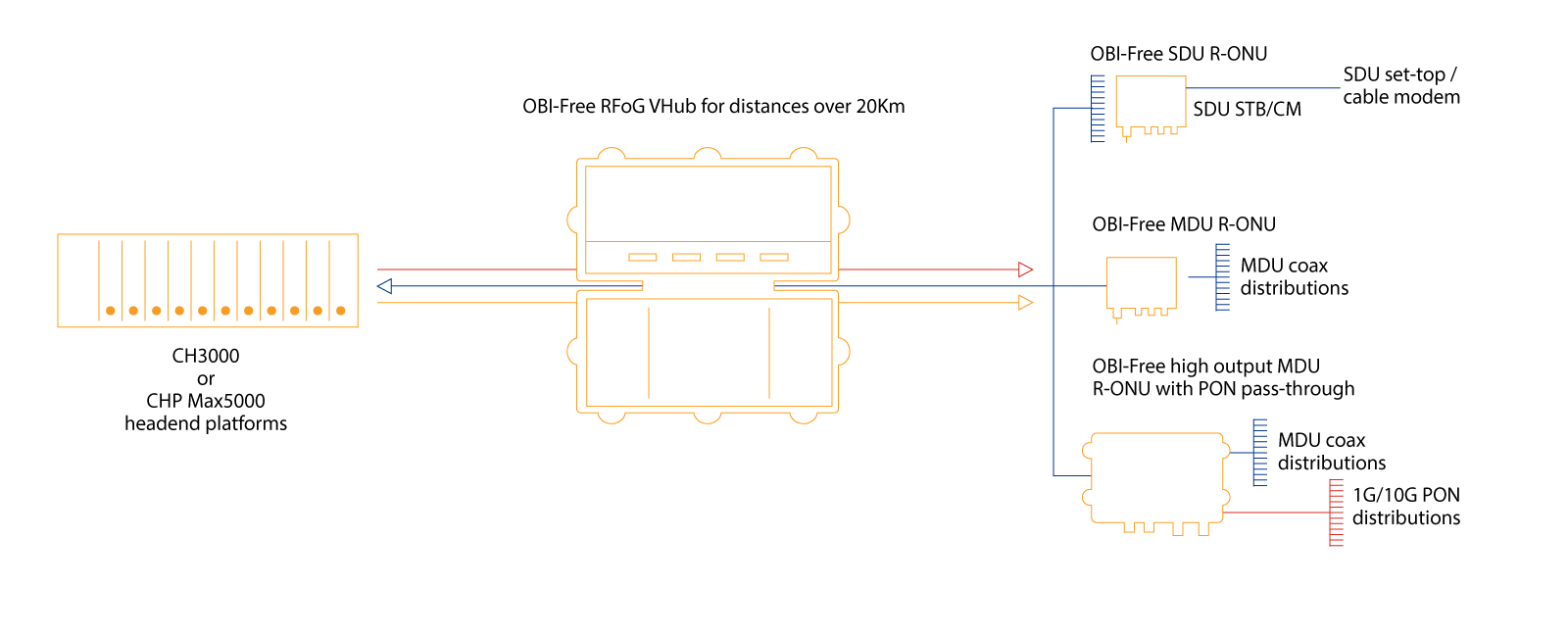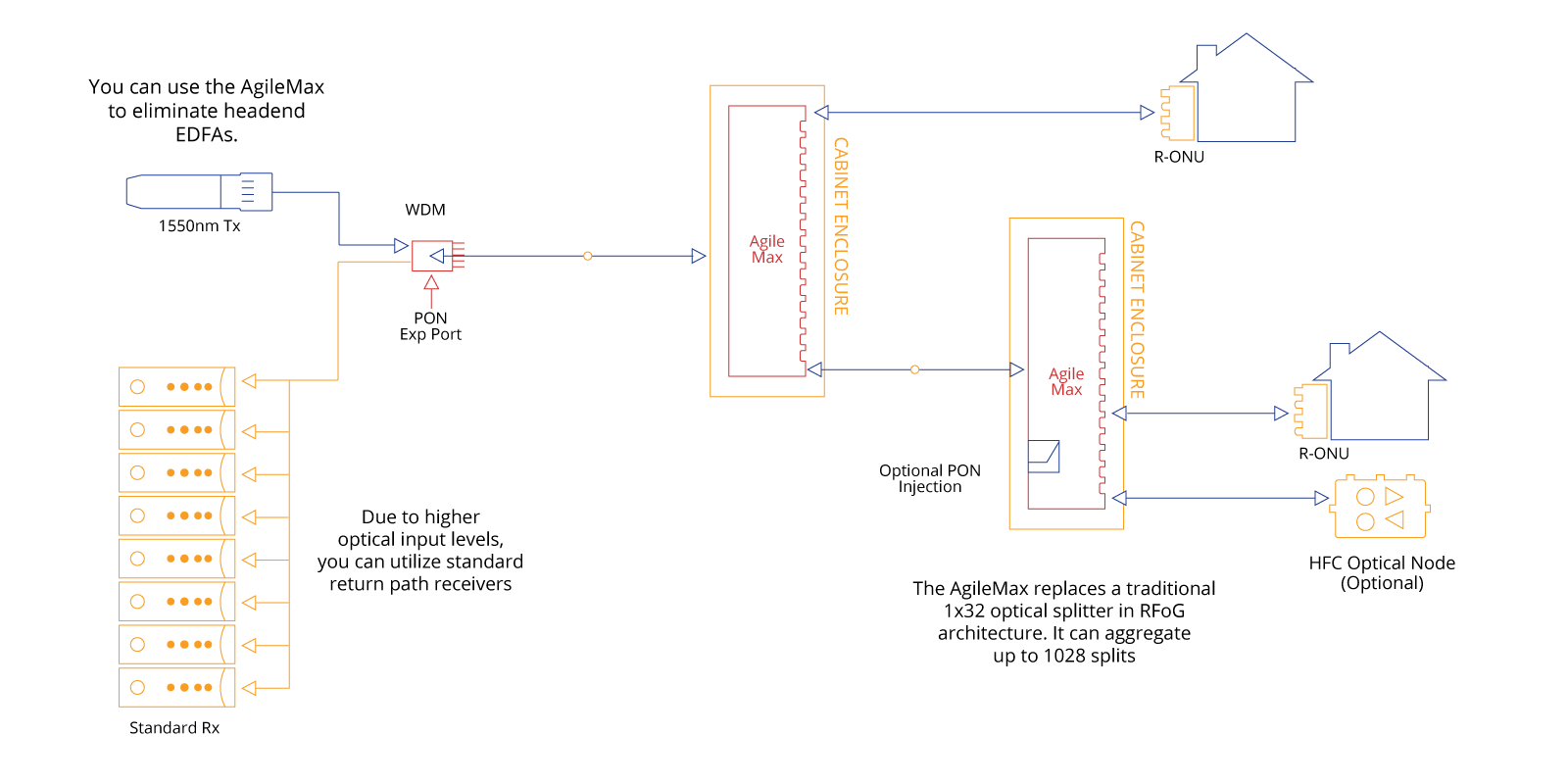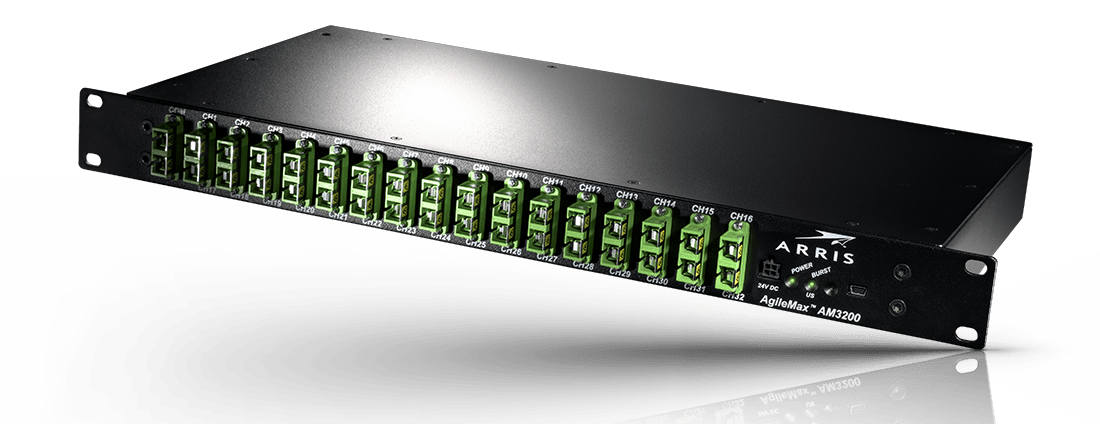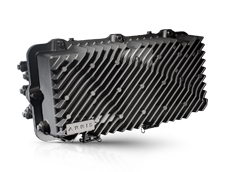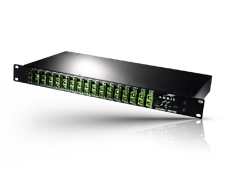Extend fiber to the premises with OBI-free RFoG
CommScope OBI-free RFoG (Radio Frequency over Glass) solutions extend fiber reach in HFC networks all the way to the home or business while retaining the existing HFC headend and customer premises equipment. By eliminating the issue of optical beat interference (OBI), they deliver the full potential of DOCSIS 3.0 and provide the infrastructure for future transition to all-fiber, 10G PON networks.
RFoG (Radio Frequency over Glass) is a fiber-deep network design in which the coaxial portion of an HFC (hybrid fiber coaxial) network is replaced by a PON (passive optical network) architecture. Fiber to the home/premises (FTTH, FTTP) makes economic sense for new build, multi-dwelling units (MDU), businesses and high-use consumers.
RFoG eliminates the need for HFC nodes, RF amplifiers, and taps and passives in the network, while utilizing the existing cable headend and subscriber equipment (modems, gateways and set-tops) and back-office support systems.
An RFoG network is capable of seamlessly delivering functionality and services to subscribers in a manner that is comparable to current HFC systems.
A CommScope RFoG network provides distinct performance advantages over current HFC networks, including:
- Provides proven support for DOCSIS 3.0 services
- Is a more economical choice for MDU and rural deployments
- Is comparable to HFC performance in greenfield suburban residential deployments
- Eliminates the RF noise and ingress inherent in coaxial deployments, to expand upstream and downstream bandwidth and significantly extend network reach
- Lowers energy costs—a greener alternative to coaxial delivery, with the added benefit of less network downtime due to power outages
- Significantly lowers operating and maintenance costs by eliminating the need for HFC nodes and RF amplifiers
- Is immune from environmental factors—such as temperature, galvanic corrosion, and humidity—that can cause coaxial cabling to degrade physically over time
- Gives multiple options to eliminate optical beat interference (OBI) in the network
- Can efficiently bridge between HFC and FTTx architectures—providing the infrastructure needed to transition to all-fiber, high-bandwidth 10G PON networks
To unlock the full potential of RFoG there are some operational challenges to address. This is especially important for migration to DOCSIS 3.0 and other next-generation delivery systems.
The challenge: Extending the network’s reach
RFoG networks were designed initially to support 32 subscribers from a single fiber feed, with a maximum distance of 20 kilometers and a 25-decibel loss budget. In densely populated urban environments, this network design easily supported large numbers of subscribers. When the time came to extend the RFoG network to large service groups in suburban and rural areas, operators found themselves exceeding the 20-km distance and 25-dB loss budget, impacting network performance. To service these groups and still realize the advantages of a fiber-based network, operators needed a cost-effective solution.
The challenge: Dealing with OBI
A second challenge of RFoG deployment is optical beat interference (OBI). In an industry where the flawless delivery of high-speed network data is paramount, OBI can be a major impediment to efficient and error-free data delivery. While a complex phenomenon, OBI can simply be explained as this: When two or more optical transmitters in the RFoG network—with closely spaced or identical wavelengths—transmit simultaneously, the upstream signal degrades at the receiver. This degradation, in turn, damages the data being transmitted on the upstream signal. Data packets are lost, and the end user experiences service interruptions. Unfortunately, traditional RFoG networks are likely to experience OBI due to the large number of R-ONUs (RFoG optical network units) at the premises all simultaneously transmitting back to the headend’s optical receiver on the same wavelength.
OBI mitigation is possible in traditional RFoG networks, but the solutions are imperfect to varying degrees. For example, a common method uses a CMTS scheduler to manage upstream bursts in a time domain. When the CMTS identifies two or more R-ONUs with sufficiently close or overlapping wavelength transmissions, it schedules one R-ONU to transmit upstream at a different time—preserving the integrity of the upstream signals. In the short term, this method is perfectly adequate. However, over time, it can prevent networks from efficiently using its full channel capacity. It also can have a real impact on the network’s future growth: As channels and bandwidth approach maximum capacity, network efficiency will decrease in proportion to the number of R-ONUs in the time domain. This could seriously hamper the ability to grow the network in parallel with consumer demand for new services and create a major roadblock to implementing DOCSIS 3.0 services.
VHub RFoG network
Aggregated AgileMax Network
The solution: CommScope “OBI-free” solutions
CommScope offers a wide range of innovative solutions that eliminate OBI in RFoG networks and support the transition to DOCSIS 3.0 services:
The AgileMax® family of fiber distribution devices: AgileMax’s active optical distribution technology replaces the optical splitters found in traditional RFoG architecture, completely eliminating OBI from the network—even if the network deploys multiple active upstream lasers. AgileMax enables service groups of up to 1,024 R-ONUs to a single head-end optical receiver port and supports less-expensive “non-tunable” R-ONUs that, with VHub technology, can extend the reach of your network to over 20 km.
OBI-free R-ONUs: CommScope OBI-free R-ONUs allow operators to select one of 16 upstream wavelengths for each unit via an internal rotary switch, providing enough wavelength separation to avoid OBI. This wavelength management approach allows multiple OBI-free R-ONUs to transmit simultaneously into a single upstream optical receiver with no chance of OBI.
CommScope offers robust, field-proven RFoG solutions designed to meet the needs of today’s evolving networks while leveraging your existing valuable network assets—solutions that enable the deployment of DOCSIS 3.0 and the expansion to 1.2 GHz with evolution paths to 10G PON architectures. Deliver the optimum solution for your network using CommScope’s powered or passive splitters, tunable R-ONUs and VHub technology.
CommScope AgileMax®—complete OBI elimination distribution solution
Leverage our leadership in video and broadband to innovate your next-generation technologies. With more than 500 access and transport patents earned over the past 60 years, CommScope has been a major contributor to the development of RFoG standards. As a leading vendor in the industry, we have shipped more R-ONUs than any other vendor, with our innovative VHub and AgileMax technologies providing a wide range of network design options.
Additional resources
-
Download
The Yin and The Yang of a Move to All Fiber: Transforming HFC to an All Fiber Network While Leveragi
This paper provides critical insights into the innovations that enable OBI Free RFoG transmission. He will discuss the intrinsic capabilities of Hybrid PON (HPON) technology, explain how this technology works with existing HFC analog and QAM video and D3.0 and D3.1 signals while also being completely transparent to the myriad of traditional PON standards such as the 10G EPON, 1G EPON, GPON, and XGPON1.
-
Download
Beat It! Handling OBI in RFoG Systems
The RF over Glass (RFoG) technology offers Hybrid Fiber Coaxial (HFC) networks with high capacity potential and extends their life deep into the 2020 decade. One of key challenges that are commonly found in RFoG systems is Optical Beat Interference (OBI). This paper is focused on analyzing the RFoG OBI phenomenon and its effect on network performance.
-
Download
The Yin and The Yang of a Move to All Fiber: Transforming HFC to an All Fiber Network While Leveragi
This paper provides critical insights into the innovations that enable OBI Free RFoG transmission. He will discuss the intrinsic capabilities of Hybrid PON (HPON) technology, explain how this technology works with existing HFC analog and QAM video and D3.0 and D3.1 signals while also being completely transparent to the myriad of traditional PON standards such as the 10G EPON, 1G EPON, GPON, and XGPON1.
-
Download
Beat It! Handling OBI in RFoG Systems
The RF over Glass (RFoG) technology offers Hybrid Fiber Coaxial (HFC) networks with high capacity potential and extends their life deep into the 2020 decade. One of key challenges that are commonly found in RFoG systems is Optical Beat Interference (OBI). This paper is focused on analyzing the RFoG OBI phenomenon and its effect on network performance.

